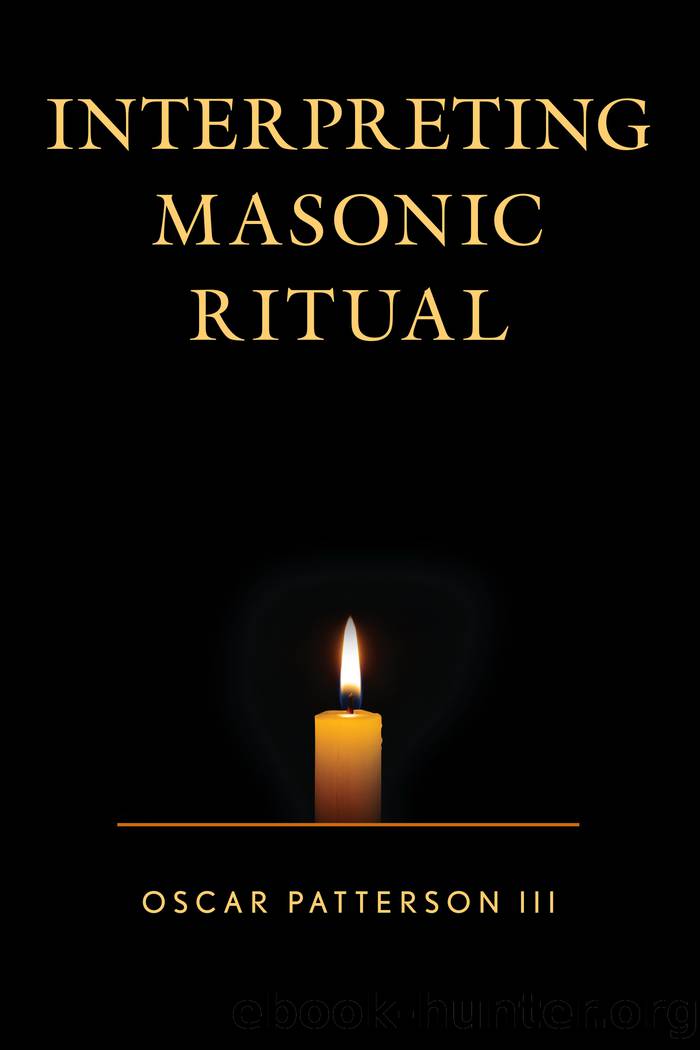Interpreting Masonic Ritual by Patterson Oscar III;

Author:Patterson, Oscar, III;
Language: eng
Format: epub
Tags: undefined
Publisher: Hamilton Books
Published: 2012-08-15T00:00:00+00:00
Note
1. Victor Turner. From Ritual to Theatre: The Human Seriousness of Play. (New York: PAJ Publications), 198 p. 15.
Chapter 6
Esotericism in Ritual
When we consider a book, we mustnât ask ourselves what it says
but what it means,
a precept that the commentators on the holy books
very clearly had in mind.
âUmberto Eco in The Name of the Rose
Pigpen cipher.
Masonic ritual is strongly based in the Western philosophical esoteric tradition and the societies which utilized it which permeated Europe beginning in the sixteenth century and found their expression in the United States beginning in the eighteenth century. The symbols of the square, compasses, plumb, level, star, columns, and rose, coupled in the eighteenth and nineteenth centuries with a renewed interested in astrology, enabled special forms of thought to be transmitted throughout a community. Symbols and reality were placed into a concordism which displayed Natureâs harmony and aided in the acquisition of knowledge about each. The cosmos was perceived as a complex and multilayered structure in which âlightâ or some type of âhiddenâ knowledge, often described as fire, was obtainable through contemplation. To know the world and manâs place in itâa sense of gnosisâled to a meditative world filled with symbolic representations of the triad of God, Humanity, and Nature.
Esotericism provides for the development and expansion of serendipitous thinking which enables the individual to imagine and meditate. The imagination facilitates the development of symbols and images into a fuller understanding of spiritual mysteries. It is a tool for knowledge of the world, the self, and the myth or legend. It reveals significations and serves to enlarge our world view. Visionary imagination as a philosophy took full form at the beginning of the seventeenth century concurrent with the rise of Freemasonry in Europe and was influenced directly by both Jewish and Christian esoteric traditions.
The esoteric tradition has traditionally embraced the concept of transmutation as an essential component. This aspect of the tradition is often misinterpreted to mean the physical change of a base element into a precious one. The true importance of esotericism as well as of initiation rituals, however, is representative of a transformation or passage from one place to another or one status to another, and not of one substance to another. A metamorphosis takes place through esoteric ritual which represents a renewal, a second chance, another opportunity, or a reaffirmation. It may also be viewed as an attempt to recover something that has been lost. A new path is taken and an old one is discarded. This mystical tradition includes purgation (divestment), illumination, and unification. This archetypical approach to tradition is most marked in âmodernâ times beginning in the late fifteenth century with the Renaissance and extended into the Enlightenment as well as into the modern world. It led to new academic explorations and influenced the study of comparative religion. It is soundly based in the concept that there is an overarching truth found in all religious and esoteric traditions. And this truth may be taught or transmitted because the knowledge is valid and the initiation is a master to disciple process.
Download
This site does not store any files on its server. We only index and link to content provided by other sites. Please contact the content providers to delete copyright contents if any and email us, we'll remove relevant links or contents immediately.
| Baha'i | Cults |
| Demonology & Satanism | Eckankar |
| Egyptian Book of the Dead | Freemasonry |
| Messianic Judaism | Mysticism |
| Scientology | Theism |
| Tribal & Ethnic | Unitarian Universalism |
The Four Agreements by Don Miguel Ruiz(6322)
Breaking Free by Rachel Jeffs(4013)
The Hatha Yoga Pradipika (Translated) by Svatmarama(3077)
120 Days of Sodom by Marquis de Sade(2943)
Member of the Family by Dianne Lake(2262)
The Tao of Physics by Fritjof Capra(2168)
The Psychedelic Gospels: The Secret History of Hallucinogens in Christianity by Jerry B. Brown(2073)
The Road to Jonestown by Jeff Guinn(1983)
Going Clear: Scientology, Hollywood, and the Prison of Belief by Lawrence Wright(1884)
Going Clear by Lawrence Wright(1872)
Uriel's Machine by Christopher Knight(1823)
The Grand Grimoire: The Red Dragon by Author Unknown(1711)
The Gnostic Gospel of St. Thomas by Tau Malachi(1680)
Key to the Sacred Pattern: The Untold Story of Rennes-le-Chateau by Henry Lincoln(1556)
The Malloreon: Book 02 - King of the Murgos by David Eddings(1517)
Waco by David Thibodeau & Leon Whiteson & Aviva Layton(1488)
The New World Order Book by Nick Redfern(1485)
The Secret of the Temple by John Michael Greer(1422)
The Initiatory Path in Fairy Tales by Bernard Roger(1395)
